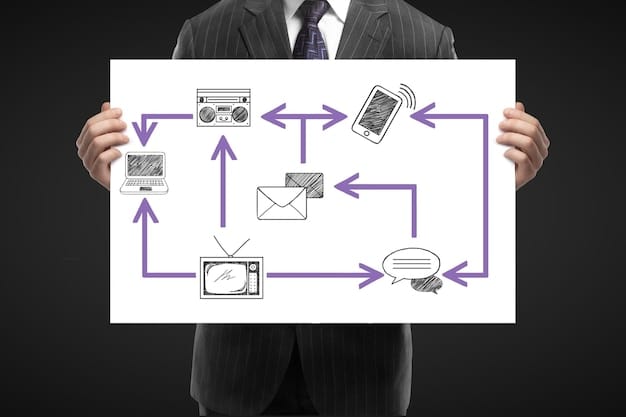Harnessing Marketing Automation: Boost Efficiency & Streamline Workflow

Harnessing the power of marketing automation involves strategically implementing software and tools to streamline repetitive marketing tasks, enhance efficiency, and improve overall campaign performance, allowing businesses to focus on strategic initiatives and deliver personalized customer experiences.
Ready to revolutionize your marketing efforts? Discover how harnessing the power of marketing automation can streamline your workflow, boost efficiency, and drive unprecedented results.
Understanding Marketing Automation
Marketing automation is more than just a buzzword; it’s a strategic approach to optimizing your marketing processes. It involves using software to automate repetitive tasks, personalize customer interactions, and ultimately, boost your bottom line.
By understanding the core principles of marketing automation, you can begin to identify areas within your workflow that could benefit from automation.
What is Marketing Automation?
Marketing automation refers to the use of software platforms and technologies to automate repetitive marketing tasks and processes. This can include email marketing, social media posting, lead nurturing, and customer segmentation.
Benefits of Automation
The benefits of marketing automation are numerous, ranging from increased efficiency to improved customer engagement. Automating tasks frees up your team to focus on more strategic initiatives and creative endeavors.
- Increased Efficiency: Automate repetitive tasks and free up your team.
- Improved Customer Engagement: Deliver personalized experiences at every touchpoint.
- Enhanced Lead Nurturing: Guide leads through the sales funnel with automated workflows.
- Better ROI: Optimize marketing campaigns for maximum impact.
Investing in marketing automation can significantly impact your overall marketing success. By streamlining processes and personalizing interactions, you can create a more effective and efficient marketing engine.

Identifying Key Areas for Automation
The first step in harnessing the power of marketing automation is identifying the areas in your marketing workflow that can be automated. This requires a thorough analysis of your existing processes and a clear understanding of your goals.
By identifying these key areas, you can strategically implement automation to maximize efficiency and impact.
Email Marketing
Email marketing is a prime candidate for automation. You can automate welcome emails, follow-up sequences, and even personalized offers based on customer behavior.
Social Media Management
Automating social media posting can save you time and ensure consistent engagement with your audience. Schedule posts, monitor mentions, and even respond to comments automatically.
- Content Curation: Automate the discovery and sharing of relevant content.
- Lead Segmentation: Automatically segment leads based on demographics, behavior, and engagement.
- Campaign Tracking: Monitor the performance of your automated campaigns and make data-driven adjustments.
Identifying the right areas for automation can transform your marketing efforts. By focusing on repetitive tasks and personalized interactions, you can unlock significant efficiencies and drive better results.
Choosing the Right Automation Tools
Selecting the right marketing automation tools is crucial for success. There are many options available, each with its own strengths and weaknesses. Choosing tools that align with your specific needs and goals will set you up for effective automation.
Consider your budget, the size of your business, and the complexity of your marketing needs when making your decision.
Popular Marketing Automation Platforms
Several popular marketing automation platforms offer a wide range of features and capabilities. Some of the leading platforms include HubSpot, Marketo, and Pardot.
Factors to Consider
When choosing a marketing automation tool, consider factors such as ease of use, integration capabilities, and pricing. Look for a platform that fits your current needs and can scale with your business.
- Integration: Ensure the platform integrates seamlessly with your existing CRM and other marketing tools.
- Scalability: Choose a platform that can grow with your business and adapt to changing needs.
- Support: Look for a platform with robust customer support and training resources.
Selecting the right automation tools will empower your marketing team and enable you to achieve your goals more efficiently. Investing time in research and evaluation will pay off in the long run.

Building Automated Workflows
Creating effective automated workflows is the key to harnessing the power of marketing automation. These workflows should be designed to guide leads through the sales funnel, nurture customer relationships, and ultimately drive conversions.
Start with a clear understanding of your customer journey and map out the touchpoints where automation can make the biggest impact.
Mapping the Customer Journey
Understanding your customer journey is essential for creating effective workflows. Identify the various stages of the journey, from awareness to purchase, and create automated sequences that address the needs of customers at each stage.
Designing Effective Sequences
When designing automated sequences, focus on delivering personalized and relevant content. Use segmentation to tailor your messaging and create workflows that are triggered by specific customer actions or behaviors.
By carefully planning and executing your automated workflows, you can create a seamless and engaging experience for your customers.
Measuring and Optimizing Results
Marketing automation is not a set-it-and-forget-it solution. To truly harness the power of marketing automation, you need to continuously measure and optimize your results. By tracking key metrics and making data-driven adjustments, you can maximize the impact of your automation efforts.
Regularly analyzing your data will help you identify areas for improvement and ensure that your automation is delivering the desired results.
Key Metrics to Track
There are several key metrics that you should track to measure the success of your marketing automation efforts. These include email open rates, click-through rates, conversion rates, and lead generation numbers.
A/B Testing and Optimization
A/B testing is a powerful tool for optimizing your marketing automation campaigns. Test different subject lines, email content, and workflow variations to see what resonates best with your audience.
- Segmentation: Refine your segmentation strategies to target the right customers with the right message.
- Content: Continuously update and improve your content to keep it fresh and relevant.
- Timing: Experiment with different send times to see when your audience is most engaged.
By continuously measuring and optimizing your results, you can ensure that your marketing automation is delivering maximum value to your business.
Common Pitfalls to Avoid
While marketing automation offers many benefits, there are also common pitfalls to avoid. Understanding these challenges and taking steps to mitigate them can help you harness the power of marketing automation more effectively.
By being aware of these pitfalls, you can steer clear of common mistakes and optimize your automation efforts for success.
Lack of Personalization
One of the biggest mistakes you can make with marketing automation is failing to personalize your messaging. Treat your customers as individuals, not just as numbers.
Over-Automation
It’s also possible to over-automate your marketing efforts. Don’t automate everything; leave room for human interaction and genuine connection with your customers.
- Ignoring Data: Regularly analyze your data to identify areas for improvement.
- Neglecting Maintenance: Keep your workflows and data clean and up to date.
By avoiding these common pitfalls, you can ensure that your marketing automation is delivering a positive experience for your customers and driving better results for your business.
| Key Point | Brief Description |
|---|---|
| ✅ Automation Benefits | Increases efficiency, improves customer engagement, and boosts ROI. |
| ⚙️ Key Automation Areas | Email marketing, social media, lead segmentation and content curation. |
| 🎯 Tool Selection | Choose tools based on integration, scalability, and support. |
| 📈 Metrics | Track open rates, click-through rates, conversion rates, and lead generation. |
Frequently Asked Questions
▼
The main goal of marketing automation is to streamline marketing efforts by automating repetitive tasks, allowing marketers to focus on strategy and creativity.
▼
Marketing automation improves customer engagement by delivering personalized content and experiences based on customer behavior and preferences, fostering stronger relationships.
▼
Common mistakes include lack of personalization, over-automation, ignoring data, and neglecting maintenance of automated workflows, which can lead to ineffective campaigns.
▼
Segmentation is crucial as it allows marketers to target specific groups with tailored messages, significantly improving engagement and conversion rates by addressing their unique needs.
▼
Key metrics include email open rates, click-through rates, conversion rates, and lead generation numbers. These provide insights into the effectiveness of automation strategies.
Conclusion
Harnessing the power of marketing automation is essential for businesses looking to streamline their workflow and boost efficiency. By understanding the benefits, identifying key areas for automation, and continuously measuring and optimizing results, you can unlock the full potential of marketing automation and drive unprecedented success.





